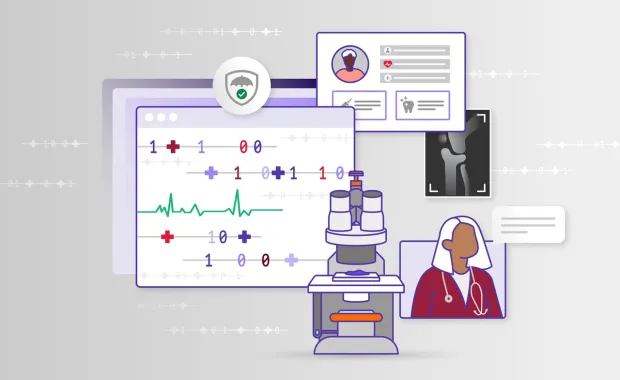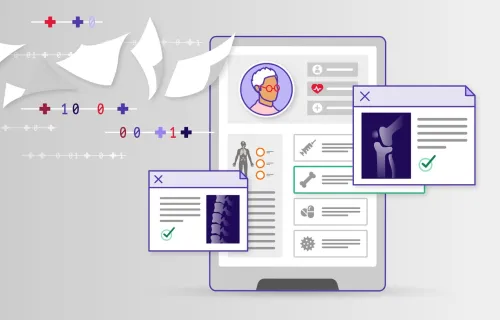Orchestrating AI: The next competitive advantage
Many organizations are racing to integrate AI into their business operations, yet few agree on how to do it well. Across health and life sciences, we’re seeing accelerating investment in artificial intelligence (AI), from clinical diagnostics and research to operations and patient experience. But behind the scenes, many organizations are confronting the same strategic dilemma:
Do we build it ourselves? Or do we partner?
This sounds like a technical question, but it’s a strategic one. And the answer has far more to do with people, systems, and trust than with models or code.
The limitations of in-house AI
There’s a natural appeal to building AI capabilities internally—total control, tailored solutions, and proprietary differentiation. For some organizations (especially those with deep engineering capacity and close alignment of AI use cases with business strategy), it can work.
But here’s what we’ve observed across the sector:
- In-house teams can struggle to scale promising prototypes; pilots succeed, but production stalls.
- Technical development often outpaces integration readiness; AI works in theory, but not in workflow.
- The burden of governance, risk, and compliance lands squarely on internal shoulders, putting additional strain on resources.
By the time a solution is ready, the technology and sometimes the problem have evolved. As a result, the opportunity window can close, and confidence can fade.
Partner-first isn’t outsourcing. It’s orchestration.
The alternative is emerging with increasing clarity: a partner-first approach, but not in the traditional sense of “outsourced services.” This model is about co-designing AI capabilities with internal stakeholders, then activating those ideas through external expertise, infrastructure, and integration.
It works because it distributes responsibility strategically:
- Internal teams stay focused on domain knowledge, governance, and change management.
- Partners deliver acceleration in the form of off-the-shelf tooling, pre-trained models, cloud-native deployment, and cross-sector insight.
Done right, a partner-first approach doesn’t slow you down. It helps you accelerate, with trust and alignment built into your strategy.
Why “built with” beats “built for”
In health and life sciences, no AI solution succeeds without workforce adoption. Whether it’s a nurse triage bot, a diagnostic imaging agent, or a clinical documentation assistant, trust is everything. That trust isn’t earned in deployment; it’s earned in design.
The most successful organizations are:
- Engaging clinicians, scientists, and staff to define what “good” looks like.
- Co-creating AI agents that fit naturally into daily routines.
- Measuring success in usability, time saved, and confidence, not just technical precision.
A partner-first approach supports these priorities by freeing internal teams to lead the 'why' and 'what', while partners focus on the 'how'.
Orchestration is the real differentiator
We often hear talk about “build vs. buy,” but the real conversation should be about orchestrating value. The next wave of AI differentiation won’t come from bespoke models or vendor lock-in; it will come from organizations that can:
- Seamlessly connect AI to existing data, infrastructure, and workflows.
- Govern AI transparently and ethically.
- Iterate as needs, risks, and technologies evolve.
This is the work of orchestration, not just invention. It means aligning people, processes, and technologies so AI doesn’t live in a vacuum. Orchestration involves coordinating tasks, data flows, and decisions across multiple systems and stakeholders, ensuring they operate in the right sequence and context. It’s how organizations move from standalone pilots to scalable, integrated capabilities, where AI becomes part of how the enterprise actually works.
What leaders are doing differently
Across the sector, the organizations getting this right are:
- Starting small, scaling fast - not by building everything, but by building on what already works.
- Thinking integration-first, not model-first.
- Prioritizing data governance and trust from day one.
- Treating AI not as a product, but as a capability to evolve alongside the enterprise.
Instead of asking, “should we build this ourselves?”, they’re asking, “what’s the fastest, safest, most trustworthy way to deliver value at scale?”
What’s your AI operating model?
The decision to use a partner-first approach isn’t just about AI strategy. It’s about how your organization chooses to move, learn, and adapt.
In healthcare, speed matters, but trust matters more. The future belongs to those who can orchestrate both. Explore our AI success stories in healthcare and beyond and contact me to discuss how we can strategically and effectively bring your organization’s AI vision to life.





